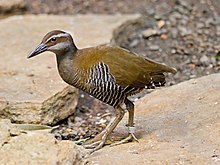| Guam rail | |
|---|---|

| |
| Guam rail at the Cincinnati Zoo | |
| Scientific classification | |
| Domain: | Eukaryota |
| Kingdom: | Animalia |
| Phylum: | Chordata |
| Class: | Aves |
| Order: | Gruiformes |
| Family: | Rallidae |
| Genus: | Hypotaenidia |
| Species: | H. owstoni
|
| Binomial name | |
| Hypotaenidia owstoni Rothschild, 1895
| |
| Synonyms | |
| |
The Guam rail (Hypotaenidia owstoni), known locally and in Chamorro as ko'ko', is a small, terrestrial bird endemic to Guam in the Rallidae family.[2][3] They are of the island's few remaining endemic bird species. The species became extinct in the wild in the early 1980s when biologists captured the remaining wild population to establish a breeding program. They have since been successfully introduced to the nearby Rota and Cocos islands.[4] In 2019, they became the second bird species to be reclassified by the International Union for the Conservation of Nature from Extinct in the Wild to Critically Endangered.[1][5]
Adult male and female plumage is primarily brown with barred black-and-white plumage on their underside. Their heads are brown with a grey stripe running above the eye and a medium-length grey bill. They have strong legs with long toes that help them walk over marshy ground.[6] Their most common vocalizations are short "kip" notes, but also screeches during the breeding season.[7]
Guam rail numbers fell drastically due to predation by invasive brown treesnakes.[4] The species is now being bred in captivity by the Division of Aquatic and Wildlife Resources on Guam, and at some mainland U.S. zoos. Since 1995, more than 100 rails have been introduced on the island of Rota in the Commonwealth of the Northern Mariana Islands, in an attempt to establish a wild breeding colony. In 2010, 16 birds were released onto Cocos Island, with 12 more being introduced in 2012.[1]
- ^ a b c BirdLife International (2019). "Hypotaenidia owstoni". IUCN Red List of Threatened Species. 2019: e.T22692441A156506469. doi:10.2305/IUCN.UK.2019-3.RLTS.T22692441A156506469.en. Retrieved 19 November 2021.
- ^ Hurrell, Shaun (20 January 2020). "How did the Guam Rail come back from extinction in the wild?". Birdlife.org. Retrieved 2 April 2020.
- ^ "Guam Rail - Guampedia". www.guampedia.com. 2009-09-30. Retrieved 2024-08-18.
- ^ a b "Conserving the Last of Guam's Avifauna: The Recovery of the Guam Rail". Smithsonian's National Zoo and Conservation Biology Institute. 2020-01-13. Retrieved 2024-08-17.
- ^ Sarah Lazarus (19 December 2019). "For the second time in history, a bird has been brought back from extinction in the wild". CNN. Retrieved 2019-12-22.
- ^ "Guam rail (ko'ko')". Smithsonian's National Zoo and Conservation Biology Institute. Retrieved 2024-08-17.
- ^ "Guam Rail - eBird". ebird.org. Retrieved 2024-08-18.
